Genoa sits between sea and mountains, inviting you to taste history and horizon. This is the home of pesto alla Genovese. An amazing, green paste full of garlic, pine nuts, and Parmigiano’s sharp taste.
This city’s culinary tour is more than just pesto. It’s a tale of Ligurian creativity. Every corner tells of real Italian food, thanks to fishermen and sailors. You’ll smell salt-air curing anchovies and hear focaccia’s crisp sound. Culinary gems like farinata and trofie pasta are hidden gems waiting to be found.
Walking Genoa’s old streets, you will learn about its food culture. It’s simple yet deep. Baccalà fritto’s salty taste meets pesto’s sweetness, a mix of sea and land. It’s more than food; it’s a story of the sea and soil.
Key Takeaways
- Genoa’s coastal geography defines its seafood-centric and herb-forward dishes.
- Pesto Genovese holds UNESCO recognition as part of Italy’s intangible heritage.
- Authentic Italian cuisine in Genoa prioritizes fresh, local ingredients over complicated techniques.
- Exploring its trattorias reveals hidden flavors like sarde a la gattò (sardines baked in saffron-tinged dough).
- Its culinary traditions reflect a blend of Mediterranean and Alpine influences.
Genoa: The Birthplace of Gastronomic Treasures

Walking through Genoa feels like entering a world of forgotten flavors. Here, Ligurian cuisine is shaped by the sea and has a quiet elegance. Yet, it’s often overlooked, overshadowed by central Italy’s pasta and sauces. The city’s magic is in its simple dishes, like briny bottarga, smooth farinata, and pesto that feels alive.
The Ligurian Influence on Italian Cuisine
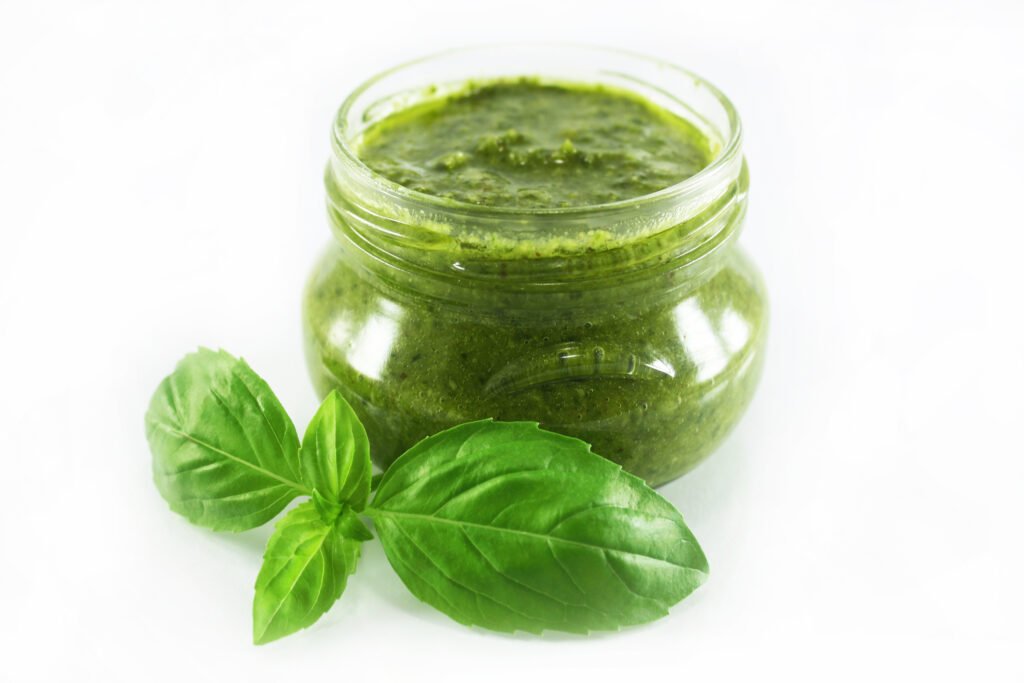
Ligurian cuisine is a whisper compared to other regions’ shouts. Unlike Bologna’s hearty ragùs or Naples’ pizza, Genoa’s dishes focus on precision. Take pesto: it’s all about balance—crushed basil, sharp garlic, and Ligurian olive oil. It’s cooking that celebrates ingredients over technique.
Why Genoa Remains Underrated in Culinary Conversations
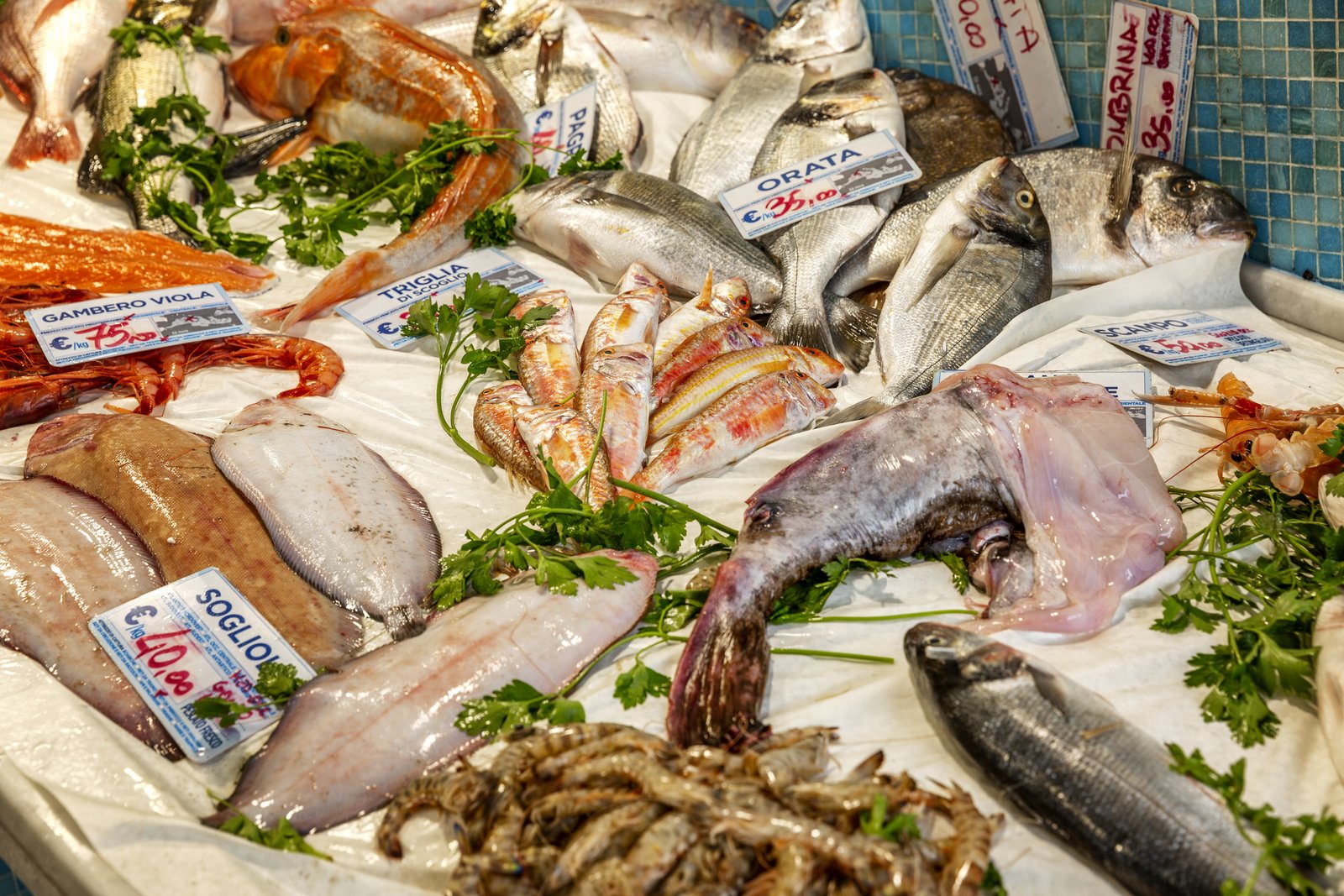
Genoa’s humility is both its blessing and curse. While Tuscany markets art and wine, Genoa’s authentic Genoese flavors stay in family kitchens. Seafood and olive-oil drizzled focaccia don’t fit the expected Italian food story. But explore the port’s markets, and you’ll find trattorias with a maritime history in every bite.
My First Encounter with Authentic Genoese Flavors
An excellent choice of restaurants is Trattoria da Nando. There the cappon magro is a seafood platter with delicate flavors. The pesto is alive, clinging to trofie pasta with a raw, herbaceous taste. It was Ligurian cuisine at its finest.
| Ingredient | Cultural Role | Sensory Highlight |
|---|---|---|
| Basilico Genovese | Soul of pesto | Sharp, herbaceous freshness |
| Pignoli (Pine Nuts) | Tradition’s crunch | Tender, lightly toasted |
| Bottarga | Sea’s treasure | Salty umami depth |
The Storied History of Pesto Genovese
Walking through Genoa’s cobblestone streets, you will find the history of Genovese pesto. It spans centuries of seafaring trade and family recipes. This vibrant sauce started as a simple mix of basil, cheese, and nuts, inspired by ancient Roman moretum. Its journey to becoming a global icon is a story of geography and creativity.
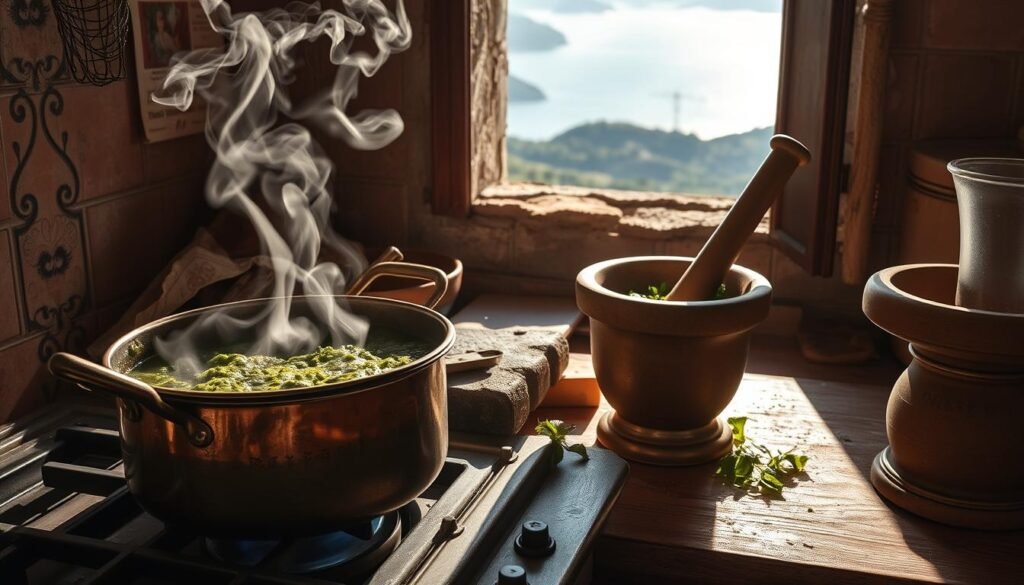
Genoa’s ships brought pine nuts from the East and basil from coastal gardens. Sailors mixed these ingredients with oil, making a meal for their voyages. This survival food turned into the pesto we love today, showing Genoese culinary heritage. Local historian Signora Bianchi once shared,
“Every spoonful holds the salt of the sea and the soil of Liguria.”
Old recipe books from the 1800s show a consistency that stands the test of time. Unlike other sauces like ragu or salsa rossa, pesto’s core ingredients have stayed the same. This simplicity reflects the pride Genovese cooks have in their traditions. Today, pesto is more than a condiment—it’s a link to the past, told through basil’s scent and the sound of a mortar.
Beyond the Basil: The Sacred Ingredients of Traditional Pesto
Walking through Genoa’s bustling markets, you will find that pesto’s soul lies in its traditional pesto ingredients. Each component is a testament to Liguria’s terroir—a symphony of flavors that demand respect.
Selecting the Perfect Basil Leaves
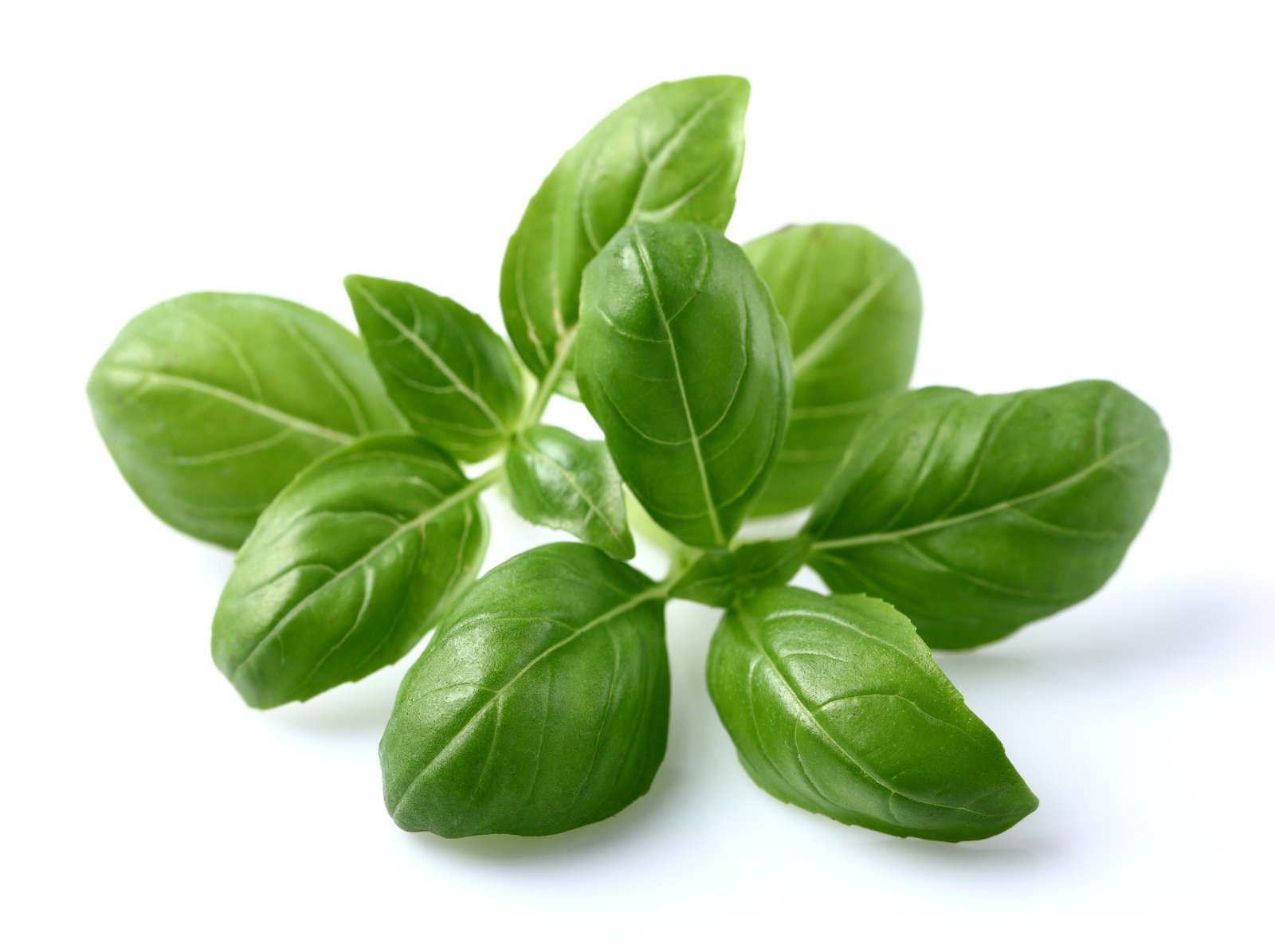
Genovese basil thrives in Pra’s sun-drenched soil, its leaves smaller and more tender than supermarket varieties. A local grower once showed me how the tightly packed leaves release a fragrance that’s both bright and earthy. “Only young plants picked at dawn carry that elusive Genovese basil essence,” she insisted, crushing a leaf in my palm.
The Great Pine Nut Debate
Pine nuts from Spain or China may be cheaper, but purists swear by the Mediterranean variety. Their delicate bitterness cuts through richness—a detail I tasted during a tasting with chef Marco Ferrero. “Substitute them, and you lose the pesto’s heartbeat,” he remarked, sprinkling a pinch into my mortar.
Cheese Considerations: Parmigiano-Reggiano vs. Pecorino
- Parmigiano adds umami depth with its crystalline crunch
- Pecorino’s tang sharpens the balance like a well-timed crescendo
At a cheese cellar in via XX Settembre, affineur Lucia Bianchi explained: “The perfect ratio depends on the pasta—shorter cuts need sharper cheeses to cling.” Her words echoed a balance of a 3:1 ratio of Parmigiano to Pecorino.
The Unsung Hero: Ligurian Olive Oil
“Oil is pesto’s silent partner—it must taste of sunlight, not bitterness,” said olive oil producer Signor Rossi, pouring a sample from his 200-year-old groves.
His Ligurian olive oil shimmered gold-green, its peppery finish merging seamlessly with the basil. Unlike robust oils, it lets the herbs sing while binding the mixture into a velvety paste.
The Ritual of Making Pesto: Mortar and Pestle vs. Modern Methods
Learning to make pesto in a Genoese kitchen you will likely find a Nonna to guide you as she smooths the ingredients using her mortar against a pestle showing patience and precision.
The Meditative Quality of Hand-Grinding
Making pesto by hand turns ingredients into a green silk. You start with basil, then garlic, cheese, and olive oil. This slow process brings out flavors like a dance.
The mortar soaks up oils, keeping the flavors close. My fingers still feel the pine nuts turning into paste. It’s a sensory experience lost with modern tools.
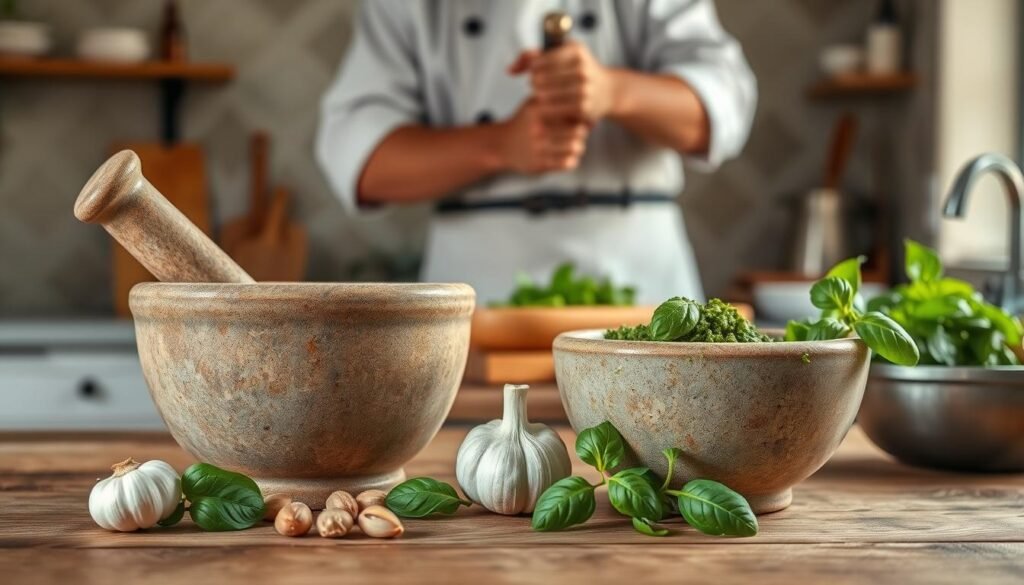
When Technology Meets Tradition: Finding Balance
Modern pesto is quick but might miss some flavors. A food processor can shred ingredients fast, but it’s not as gentle as a mortar. Here’s how they compare:
| Aspect | Traditional | Modern |
|---|---|---|
| Texture | Creamy, uneven pockets of basil | Uniform but silky |
| Time | 10–15 minutes | 2 minutes |
| Flavor Intensity | Layered, herb-forward | Blended consistency |
Many Genoese cooks mix old and new. They blend ingredients briefly, then finish by hand. This way, they keep the mortar’s texture while using modern tools.
Even the herb-infused pesto-stuffed turkey I made uses this mix. It blends modern efficiency with traditional soul.
The mortar’s sound is more than just noise. It’s a bridge to the past. Modern tools are just that—tools. Choosing the right one keeps pesto’s essence alive.
A Culinary Tour of Genoa: Neighborhoods and Their Signature Dishes
Start a journey through Genoa’s culinary tour of Genoa. Each Genoese neighborhoods tells its own story through local food specialties. The city’s flavors are as rich as its streets.
Porto Antico’s Seafood Treasures
Porto Antico’s harbor buzzes with Mediterranean vibes. Tables by the water let you see fishermen selling their catch. I tried five types of anchovies, each showing the sea’s wealth.
The sunset was stunning as I enjoyed wine. Here, freshness is a must.
The Hidden Gems of Boccadasse
Boccadasse’s colorful houses hide simple trattorias. A family-run place served a seafood risotto that felt like the coast. The chef said recipes stay the same since his grandfather’s time.
Here, locals enjoy fritto misto and pansoti pasta, away from tourists.
Castelletto’s Panoramic Dining Experiences
The Montegalletto lift takes you to Castelletto’s terraces. These spots offer stunning views and dishes like pansotti al pesto. A trattoria paired meals with Rossese wine, with vineyards in sight.
The mix of views and tastes here is truly Genoese.
Like Verona’s markets, Genoa’s neighborhoods have stories in every bite. Each dish is a conversation between land, sea, and tradition.
The Trattorie Experience: Where Locals Savor Authentic Pesto

Walking into Genoa’s authentic Genoese trattorie is like stepping back in time. At Trattoria da Maria, the smell of garlic and olive oil greets you warmly. These traditional pesto restaurants focus on simplicity, with no English menus and chalkboard specials.
The atmosphere buzzes with life. Grandparents and teenagers chat over pasta and farinata.
At Sa’ Pesta, servers warm bowls to keep pesto fresh. The trenette al pesto comes with a burst of basil steam. It’s all about timing: Monday nights are for pesto with trofie at Sa’ Pesta, and Tuesday is focaccia day at Trattoria da Maria.
| Day | Signature Dish | Trattoria |
|---|---|---|
| Monday | Trofie al pesto | Sa’ Pesta |
| Tuesday | Focaccia con funghi | Trattoria da Maria |
| Thursday | Pansé | Trattoria del Molo |
- Seek family-run spots with mismatched chairs
- Ask waiters’ children for recommendations—they know every trattoria’s schedule
- Expect meals under €15, a testament to Liguria’s humble culinary soul
Learning to toss pasta at Sa’ Pesta showed me their dedication. These places resist modern trends, keeping Genoa’s culinary spirit alive. For more, check out culinary guides that highlight these gems. Every bite here is a tradition passed down through generations.
Focaccia: Genoa’s Other Culinary Masterpiece
Every morning in Genoa, you can explore the streets, following the smell of wood-fired ovens. The scent of sea air mixed with yeast was irresistible. You may want to try the authentic Genoese focaccia at a local traditional Italian bread bakery. It was a warm, oil-kissed slice with a strong espresso.
The Perfect Texture: Crisp Yet Tender
A true authentic Genoese focaccia is a mix of textures. Its crust is like autumn leaves, but inside, it’s soft like a cloud. The dimples hold Ligurian olive oil, showing that traditional Italian bread can be light and flavorful.
The bottom crust is caramelized, telling stories of slow fermentation and local ovens.
Regional Variations That Tell a Story
“Focaccia is our diary,” said a baker in Boccadasse, dusting flour onto his board. “Each mark is a memory.”
From the western coast to the French border, regional focaccia variations change like the tides. Near the riviera, focaccia becomes socca, a chickpea-flour bread with saffron. Near the mountains, it’s stuffed with cheese, showing Alpine influences.
Each version tells a story of soil, trade, and tradition.
Why American Interpretations Miss the Mark
Most focaccia abroad lacks the time and technique of the traditional Italian bread. American focaccia is often soft and lacks the tang from 12-hour fermentation. The oil used is always Ligurian extra-virgin.
This is not just bread—it’s a tradition kept alive by generations.
Genoa’s Street Food Revolution: Traditional Meets Contemporary
Walking through Genoa’s bustling alleyways, the Genoese street food scene is alive. It combines old traditions with new ideas. At the center is farinata, a crispy farinata chickpea pancake that shows off Ligurian creativity.
The crust was thin and smoky, while the inside was soft and melts in the mouth.
Farinata: The Chickpea Delight You Never Knew You Needed
Artisans make farinata in front of crowds, using chickpea batter. This dish was once for workers but now is gluten-free. The smell of chickpea flour fills the air, reminding us of the past.
Modern Food Markets Reshaping Genoese Cuisine
In contemporary Italian food markets like Mercato Orientale Centro, old and new meet. Elderly farmers give wild herbs to chefs making farinata with rosemary or truffle. This mix of old and new is exciting.
These markets are more than just places to buy food. They are where stories come to life with every bite. The air is filled with discussions about food, showing Genoa’s love for change and tradition.
The Unexpected Pairings: Pesto Beyond Pasta
In Genoa,pesto’s true power is discovered : it connects flavors in new ways. It’s not just for pasta anymore. This sauce can change any dish, surprising even the most experienced cooks. Try minestrone alla Genovese with a dollop of pesto for a burst of basil flavor—a creative pesto use loved by locals.
At Easter markets, look for non-pasta pesto dishes like ripieni. These are zucchini and eggplant stuffed with pesto, then baked until soft, evidence that pesto has the ability to enhance flavors, not just add them.
- Seafood harmony: At Boccadasse’s docks, chefs mix pesto with grilled branzino. It balances the fishy taste with garlic and basil.
- Risotto revelation: A chef in Castelletto told me pesto makes risotto creamy and green. It’s great with mushrooms or artichokes.
- Sweet surprise: A gelato shop near Porto Antico offers pesto-flavored ice cream. Its sharpness cuts through sweetness, showing pesto food pairings have no limits.
“Pesto is a language,” said Signora Lombardi, a trattoria owner. “It talks about freshness, not being stuck in one way.” My travels showed pesto’s zesty taste can brighten roasted veggies or dress salads. Next time you use pesto, let your curiosity lead. Genoa’s kitchens show there’s no wrong way to mix tradition with creativity.
From Fishing Village to Culinary Destination: Genoa’s Transformation
Walking Genoa’s cobblestone streets, this port city’s culinary history moved from a focus on preserved foods for sailors to a place loved by food lovers worldwide. The smell of basil and salt air reminds me of the sea journeys.
The Maritime Influence on Genoese Cooking
Genoa’s connection to the sea shaped its food. Traders brought in basil from India, tomatoes from the New World, and spices from North Africa. Dried beans, anchovies, and olive oil became key ingredients, like in pansoti with walnut sauce. Here’s a look at this legacy:
| Traditional | Modern Interpretation |
|---|---|
| Salt-cured fish | Artisanal fish markets |
| Preserved vegetables | Small-batch pickling workshops |
| Seafood stews | Chefs reimagining cima alla genovese |
How Tourism Has Both Preserved and Changed Traditional Recipes
Tourism has a mixed effect on local food. Farinata, a chickpea flatbread, is still a favorite street food. But, some places now add truffles to attract visitors. “We keep pesto’s core ingredients intact but try new pairings,” said a chef. It’s a balance between keeping things true and trying new things.
Genoa’s story is like many Mediterranean cities. Tourism can risk changing the local food but also helps keep it alive. By eating dishes like stoccafisso (dried cod), visitors help keep Genoa’s food traditions alive. From fishing boats to Michelin-starred kitchens, Genoa’s food is a living tradition, always moving forward.
Why Every Home Cook Should Master Genoese Techniques
Learning Genoese cooking techniques is more than just making pesto. It opens the door to Italian culinary skills that elevate simple meals. My kitchen changed when I started using their simple methods. The battuto, a mix of onions, celery, and carrots, is key to many dishes. It shows how basic techniques can add flavor without being complicated.
Genoese chefs handle herbs with care, never overworking them. This approach teaches us to respect our ingredients. Their wisdom about olive oil is also valuable. Knowing when to use it adds depth to dishes that many cooks miss.
- Frugal brilliance: Genoa’s cucina povera turns simple ingredients into amazing dishes. Think stale bread as a salad base or vegetable scraps for broth.
- Texture mastery: Their focaccia and pasta show how technique makes a big difference in quality.
- Adaptability: These methods work beyond Italian dishes. Try adding a battuto under your next casserole, like in this cheesy chicken pasta bake—it enhances flavors.
Every action in Genoese cooking tells a story. Mastering these skills is about finding beauty in simplicity. It teaches us to listen to our ingredients, not just follow recipes. Whether making a ragu or a stir-fry, Genoa’s lessons of economy and elegance make every meal special.
Conclusion: Carrying Genoa’s Culinary Legacy Forward
Exploring Genoa’s kitchens showed me that keeping food traditions alive is more than just preserving the past. It’s about making them vibrant and relevant today. Every pesto made with fresh basil and cheese, and every focaccia bite, carries a piece of Italy’s rich history.
But Genoa’s cuisine also looks to the future. It blends old traditions with new flavors, creating a unique taste that excites. I saw this in the busy trattorias where young chefs add their own twist to classic dishes like farinata.
If you want to connect with Genoa’s culinary past, there are many ways to do it. Try using sun-dried basil from Liguria or making pesto with pine nuts. These small steps honor the long history of Genoese cooking.
Plan a visit to Boccadasse for its seafood stew or Porto Antico’s markets. These places are filled with stories in every dish. Even making pesto at home is a way to keep this tradition alive.
Genoa’s cuisine teaches us that Italian food is a living conversation. It’s about enjoying history through today’s dishes while respecting the old ways. Whether you’re mastering a mortar or enjoying street food, connecting with these traditions is like embracing the Mediterranean sun.
Let’s keep this culinary legacy alive. Not as something old and static, but as a dynamic celebration of taste and culture that continues to evolve.

